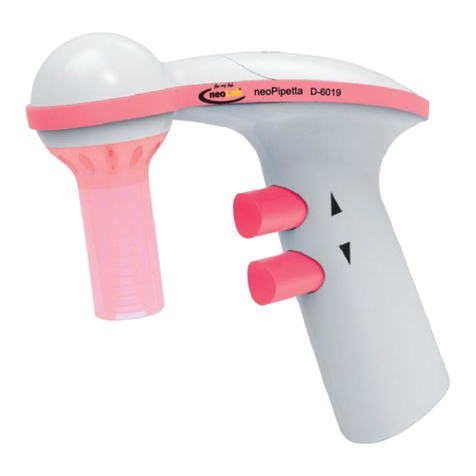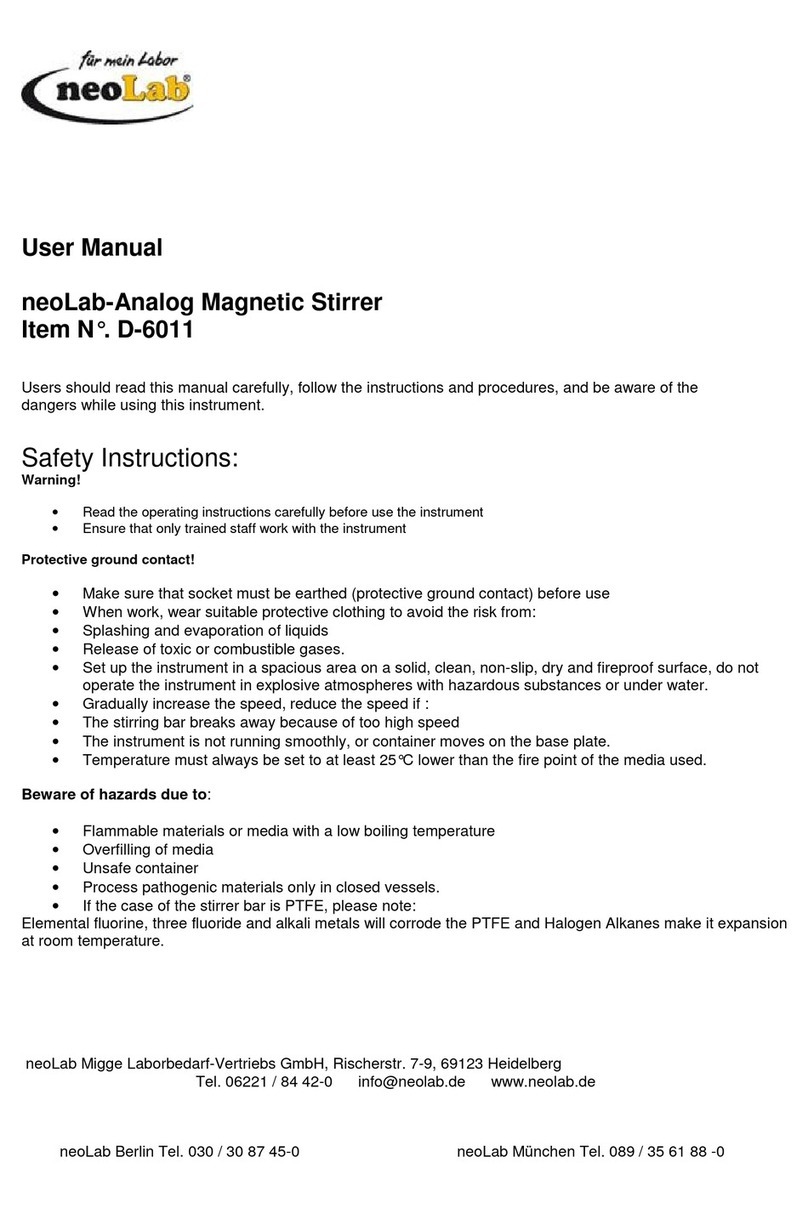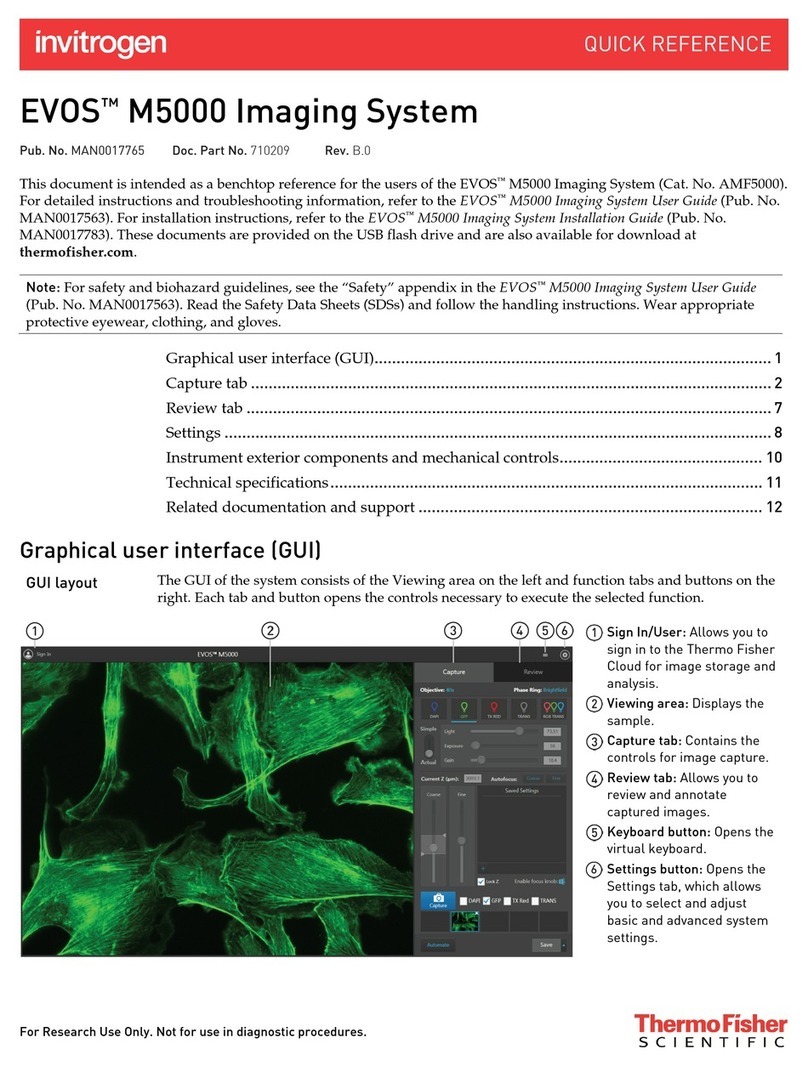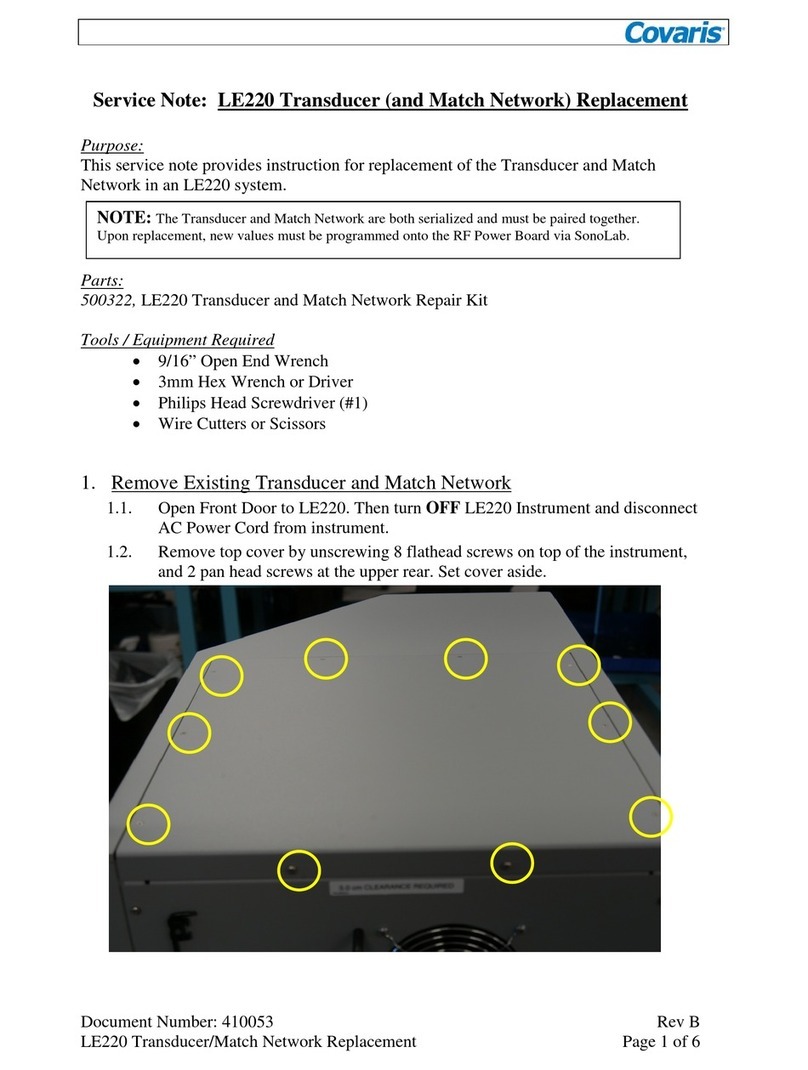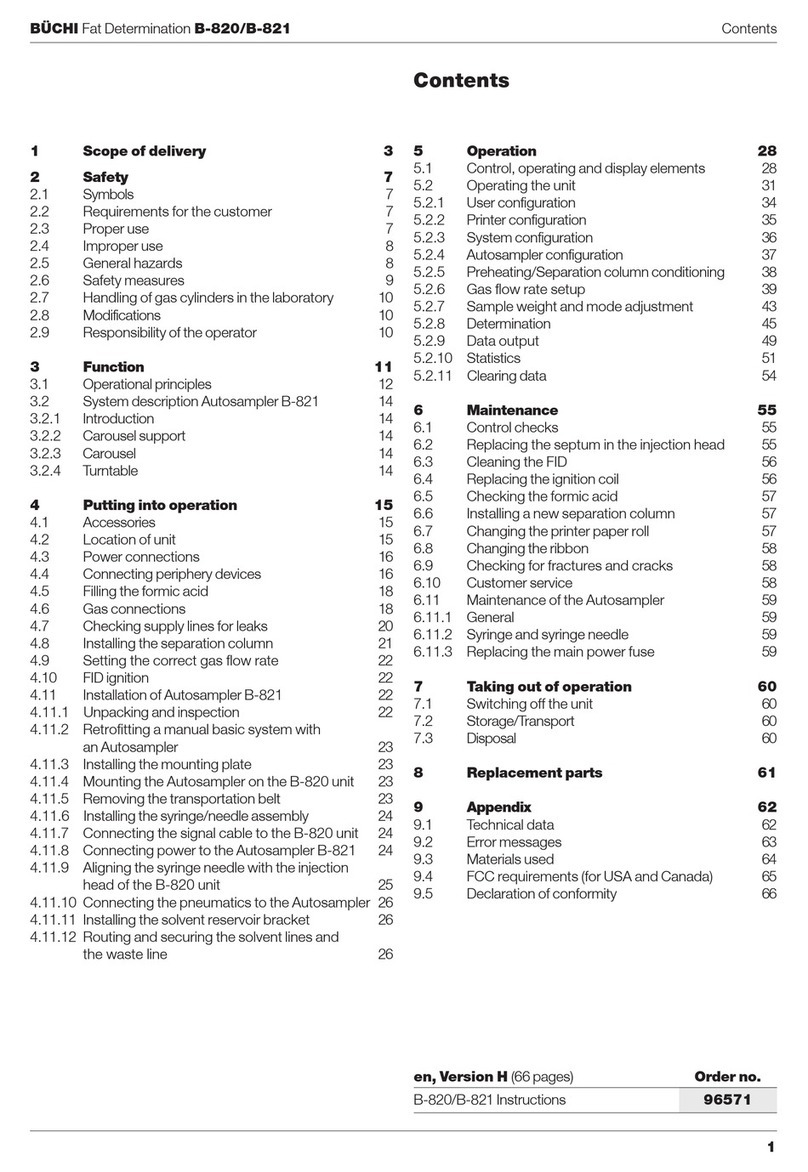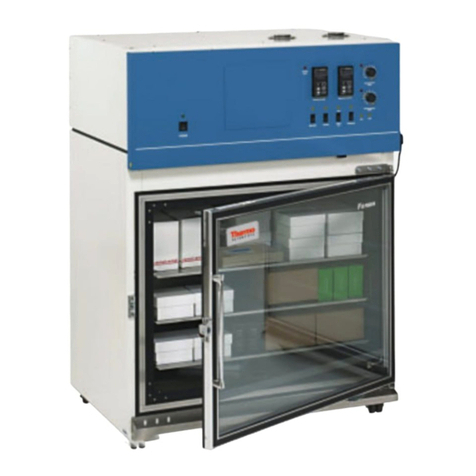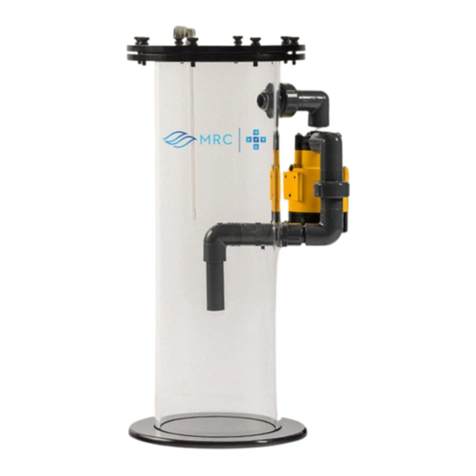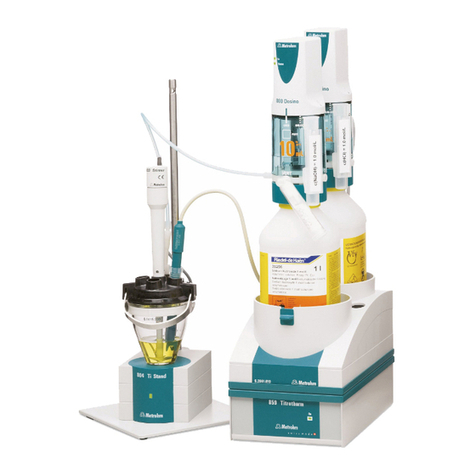Neolab D-6010 User manual

User Manual
Digital Hotplate Magnetic Stirrer
Item N°. D-6010
Users should read this Manual carefully, follow the instructions and procedures, and be aware of the
dangers while using this instrument.
Safety Instructions
Warning!
•Read the operating instructions carefully before use the instrument
•Ensure that only trained staff work with the instrument
•Forbid to heat the substances with low burning point or easy-volatile( hotplate )
Risk of bum!
•Caution when touching the housing parts and the heating plate.
The heating plate can reach temperatures of 340°C!
•Pay attention to the residual heat after switching off.
Protective ground contact!
•Make sure that socket must be earthed (protective ground contact) before use
•When work, wear suitable protective clothing to avoid the risk from:
•Splashing and evaporation of liquids
•Release of toxic or combustible gases.
•Set up the instrument in a spacious area on a solid, clean, non-slip, dry and fireproof surface, do not
operate the instrument in explosive atmospheres with hazardous substances or under water.
•Gradually increase the speed, reduce the speed if :
•The stirring bar breakaway because of too high speed
•The instrument is not running smoothly, or container moves on the base plate.
•Temperature must always be set to at least 25°C lower than the fire point of the media used.
Beware of hazards due to:
•Flammable materials or media with a low boiling temperature
•Overfilling of media
•Unsafe container
•Process pathogenic materials only in closed vessels.
•If the case of the stirrer bar is PTFE, please note:
Elemental fluorine, three fluoride and alkali metals will corrode the PTFE and Halogen Alkanes make it expansion
at room temperature. Molten alkali, alkaline earth metals or their solution, as well as the powder in second and
third ethnic of the periodic table of Elements will have chemical reaction with PTFE when temperature reaches
300 – 400°C.
neoLab Migge Laborbedarf-Vertriebs GmbH, Rischerstr. 7-9, 69123 Heidelberg
neoLab Berlin Tel. 030 / 30 87 45-0 neoLab München Tel. 089 / 35 61 88 -0

•Check the instrument and accessories before hand for damage each time you use them. Do not use
damaged components. Accessories must be securely attached to the device and cannot come off by
themselves. Always disconnect the plug before fitting accessories.
•Ensure that the external temperature sensor is inserted in the media to a depth of at least 20 mm.
•When using metal vessels, do not place the temperature sensors on the bottom of the vessel. Placing
sensors on the vessel bottom can cause excessively high temperatures to be measured especially in
media which have poor conductivity. The tip of the measuring sensor must be at least 5 mm from
the vessel bottom; a distance of 10 mm is ideal.
The instrument can only be disconnected from the main power supply by pulling out the mains plug or the
connector plug.
•The voltage stated on the label must correspond to the main power supply.
•Ensure that the mains power supply cable does not touch the heating base plate. Do not cover the
device.
•The instrument may only be opened by experts.
•Keep away from high magnetic held.
•Observe the minimum distances between the devices, between the device and the wall and above the
assembly (min. 100 mm).
Proper use
The instrument is designed for mixing and/or heating liquids in schools, laboratories or factories. This device is
not suitable for using in residential areas or other constraints mentioned in Chapter 1.
Inspection
Unpack the equipment carefully and check for any damages which may have arisen during transport. If it
happens, please contact neolab for technical support.
Trial run
•Make sure the required operating voltage and power supply voltage match.
•Ensure the socket must be earthed reliably.
•Ensure the power be off.
•Plug in the power cable, ensure the power be on and begin initializing.
•Add the medium into the vessel with a stirring bar.
•Put the vessel on the work surface.
•Set the rated stirring speed and start stirring.
•Observe the stirring bar and LCD display.
•Set the rated temperature and start heating.
•Observe the real temperature on LCD display.
•Stop the heating and stirring functions.
If these operations above are normal, the device is ready to operate. If these operations are not normal, the
device may be damaged during transportation, please contact neolab for technical support.
neoLab Migge Laborbedarf-Vertriebs GmbH, Rischerstr. 7-9, 69123 Heidelberg
neoLab Berlin Tel. 030 / 30 87 45-0 neoLab München Tel. 089 / 35 61 88 -0

Function: Heating
The device is controlled by Digital Temperature Control Technology, which has two separate safe circuits.
The hotplate is kept at a constant temperature by a digital control circuit. The hotplate temperature can also be
monitored from a separate, adjustable safety circuit. The two temperature sensors (Pt1000) internal for
temperature control are built-in the hotplate. The single external Ptl000 can monitor the temperature of sample.
If external temperature sensors needed, it must be plugged in. Stirring bar breakaway monitoring can be set in
this mode.
.
Function: Stirring
The function "stirring" is switched ON or OFF via the rotary stirring knob. The motor speed is set on the knob
(100 to 1500 rpm in steps of 10 rpm).
When both, the function heating and stirring, are switched on and those above operations are done,
the LCD will shift to the speed value and come back to the temperature value in about 5 seconds.
Remote control:
The unit can be controlled from an external PC (using the dedicated software) via the RS232 C serial interface
fitted to the unit. Data communication from laboratory instrument to computer is only possible on demand of the
computer.
•The functions of the interface lines between laboratory instrument and automation system are selected
from the specified signals of the ElA-standard RS232 C, corresponding with DIN66020 part 1. The
allotment of the bushing can be taken from illustration.
•For the electrical properties of the interface lines and for the allotment of the signal status, standard
RS232 C, corresponding with DIN66259 part I applies.
•Transmission method: Asynchronous signal transmission in start-stop-operation.
•Mode of transmission: Fully Duplex.
•I start bit; 7 character bits; I parity bit [straight (even]); 1 stop bit.
•Transmission speed:9 600 bit/s
neoLab Migge Laborbedarf-Vertriebs GmbH, Rischerstr. 7-9, 69123 Heidelberg
neoLab Berlin Tel. 030 / 30 87 45-0 neoLab München Tel. 089 / 35 61 88 -0

Faults:
•Instrument can' t be power ON:
-Check whether the power cable is plugged
-Check whether the fuse is broken or loose
-Fault in power on self test
-Switch OFF the unit, then switch ON and reset the instruments to factory default setting.
•Temperature cannot reach set point:
Check whether the safety temperature value is set too low
•Stir speed cannot reach set point:
-Check whether the stirring bar breakaway monitoring is ON
-Excessive medium viscosity may cause abnormal speed reduction of the motor
•Heating cannot be started when push the temperature control knob, or stirring cannot be
started when push the speed control knob:
-Check whether the unit is in the mode setting program,
-Exit from the mode settinq and restart the heating/stirring functions.
•Unit cannot be powered off when switched off.
-Check if the residual heat warning function is still ON and hotplate temperature is above 50°C
(the LCD still work and "Hot" flash).
-Turn off residual heat warning function before powered OFF the unit.
If these faults are not resolved, please send the instrument back.
Maintenance and Cleaning
•Proper maintenance can keep instruments working in a good state and lengthen its lifetime.
•Be careful not spray the cleanser into the instrument when cleaning.
•Unplug the power line when cleaning,
•Only use cleanser that we advised as below:
-Wear the proper protective gloves during cleaning of the instrument.
-Before using other method for cleaning or decontamination, the user must be sure that this
method does not destroy the instrument.
•The instrument must be cleaned and put it into the initial packaging carton before sending to service for
repair, avoiding the contamination of hazardous.
•Use the instrument in a dry clean room and temperature stable environment.
neoLab Migge Laborbedarf-Vertriebs GmbH, Rischerstr. 7-9, 69123 Heidelberg
neoLab Berlin Tel. 030 / 30 87 45-0 neoLab München Tel. 089 / 35 61 88 -0

Technical data:
Voltage: 220-240
Frequency Hz: 50/60
•The safety temperature range of the hotplate 100-350 [C ]
•Temperature sensor in medium PT1000
•Control accuracy of heating temperature with temperature sensor 0,2 C
•Dimensions (mm) 2 8 0 x 1 6 0 x 8 5
•Permitted ambient temp. 5-40°C
•Permitted relative humiditv: 80%
•Protection class acc. to DIN 60529: IP 42
•RS232 interface: Yes
•Stirring point position: 1
•Max. stirring quantity(H2O): 20 L.
•Max. magnetic bar: 80 mm
•Motor type: External rotor, brushless motor
•Max. power input of motor: 18 W
•Max. power output of motor: 10 W
•Speed range [rpm]: 100~1500
•Rotary speed display: LCD
•Speed display accuracy [rpm]: 1
•Hotplate material: stainless steal
•Hotplate diam.: 135 mm
•Heating power: 500 W
•Temperature range (C): RT~340
•Temperature display accuracy: 0,1°C
•Control accuracy of heating temperature: 1°C
neoLab Migge Laborbedarf-Vertriebs GmbH, Rischerstr. 7-9, 69123 Heidelberg
neoLab Berlin Tel. 030 / 30 87 45-0 neoLab München Tel. 089 / 35 61 88 -0
Table of contents
Other Neolab Laboratory Equipment manuals
Popular Laboratory Equipment manuals by other brands
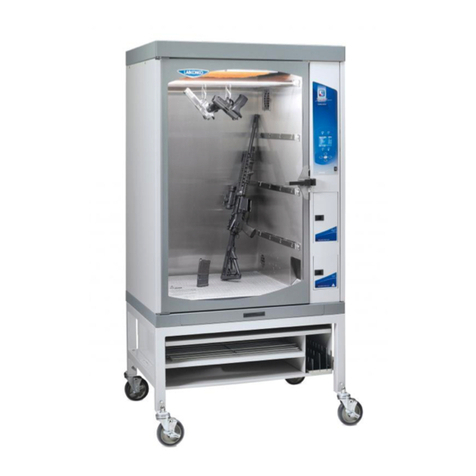
Labconco
Labconco Capture BT 31700-00 user manual
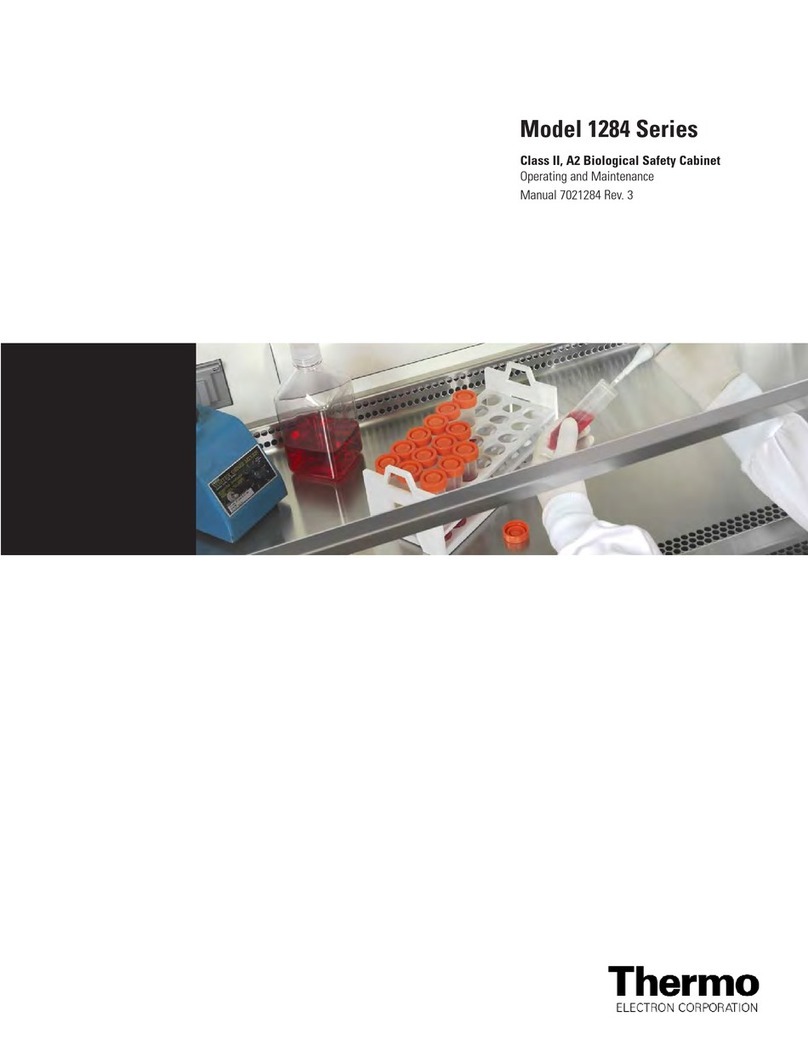
Thermo
Thermo 1284 Operating and maintenance manual
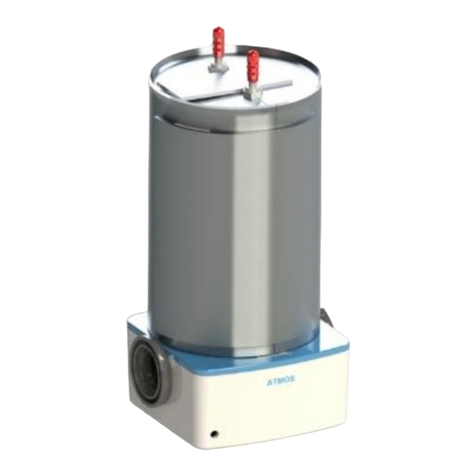
Specac
Specac ATMOS A2.5 quick start guide

Beckman Coulter
Beckman Coulter Optima MAX-TL Instructions for use
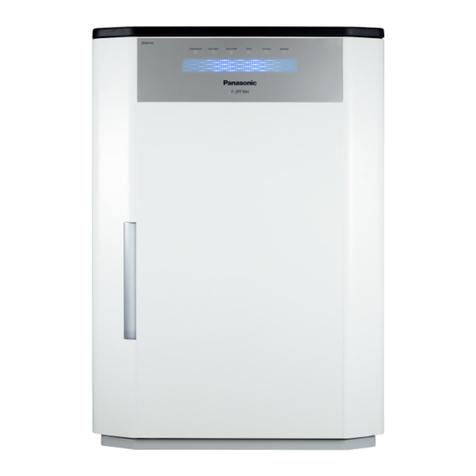
Panasonic
Panasonic ZIAINO F-JPU70M operating instructions

NEW BRUNSWICK SCIENTIFIC
NEW BRUNSWICK SCIENTIFIC BIOFLO III Guide to operations
